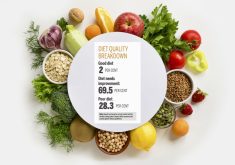If everyone on the planet wanted to eat a healthy diet, there wouldn’t be enough fruit and vegetables to go around.
A team of researchers at the University of Guelph compared global agricultural production with nutritionists’ consumption recommendations and found a drastic mismatch.
“We simply can’t all adopt a healthy diet under the current global agriculture system,” said study co-author Prof. Evan Fraser, holder of the Canada Research Chair in Global Food Security. “Results show that the global system currently overproduces grains, fats and sugars, while production of fruits and vegetables is not sufficient.”
Read Also

Seeding Indigenous agricultural prosperity
National Circle for Indigenous Agriculture and Food says Indigenous agricultural success needs strong relationships.
Published in the journal PLOS ONE, the study calculated the number of servings per person on the planet for each food group based on the Harvard University’s “Healthy Eating Plate” guide, which recommends that half of our diet consist of fruits and vegetables; 25 per cent, whole grains; and 25 per cent, protein, fat and dairy.
Researchers calculated how much land is currently used for farming and how much would be needed if everyone followed the nutritional recommendations. They then projected those numbers for 2050, when the global population is expected to reach 9.8 billion.
They found that we now produce 12 servings of grains per person instead of the recommended eight; five servings of fruits and vegetables instead of 15; three servings of oil and fat instead of one; three servings of protein instead of five; and four servings of sugar instead of none.
“What we are producing at a global level is not what we should be producing according to nutritionists,” said Fraser.















